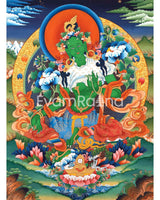
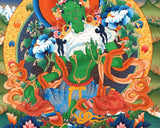
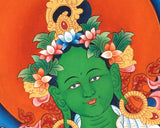
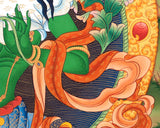
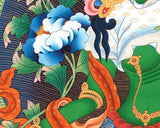
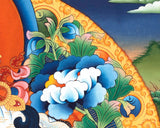


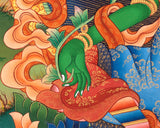

Green Tara Bodhisattva Thangka | Cotton Canvas Spiritual Art

100% AUTHENTIC

HANDPAINTED

FREE SHIPPING
Green Tara Bodhisattva
Introduction To The Thangka :
Green Tara came into existence from a tear of Avalokiteshvara, which fell to the ground and formed a lake. Out of its waters rose up a lotus, which, on opening, revealed the goddess.
Green Tara is adorned in silken garments and jeweled ornaments. The main difference on the iconography between the green Tara and the white Tara is the position of the legs. Green Tara sits in a posture of ease, with one leg drawn towards her and the other resting on a lotus bud that springs from the pedestal. Her hands are in the mudra of perfect generosity, holding the stems of blue lotus showing a peaceful and smiling expression.
How to take care of your thangka?
-Hang your thangka in a traditional silk brocade
-Regular Inspection of your thangka; examine the borders and all attachments.
-Keep thangkas covered when they are on display but not in use.
-Rotate thangkas between display and storage on a regular basis, two to four times a year, to reduce the amount of exposure to light. Keep away from sunlight and humidity.
-Do not apply liquids or other materials to the surface of the thangka.
---------------------------------------------------------------------
Size: 18"/ 46 cm (width) x 24"/ 61 cm (height)
Materials: Cotton Canvas, Acrylic Colors, Genuine 24K Gold
----------------------------------------------------------------------
THIS THANGKA IS HAND-PAINTED IN THE TRADITIONAL STYLE AND THE QUALITY IS HIGH
---------------------------------------------------------------------------
How does Thangka help us?
Historically used as a teaching aid, thangkas are used as a meditation tool to help bring one further down the path to enlightenment. Devotional images act as the centerpiece during a ritual or ceremony and are often used as mediums through which one can offer prayers or make requests.
How to Take Care of Your Thangka?
- Hang your thangka in a traditional silk brocade.
- Regularly inspect your thangka; examine the borders and all attachments.
- Keep thangkas covered when they are on display but not in use.
- Rotate thangkas between display and storage two to four times a year to reduce exposure to light. Keep them away from sunlight and humidity.
- Do not apply liquids or other materials to the surface of the thangka.




















